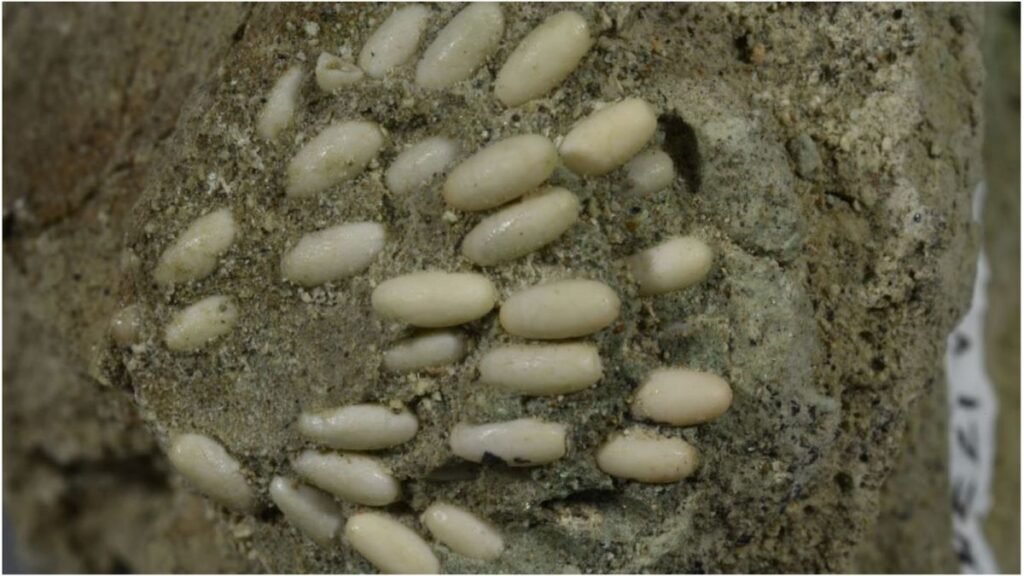
Scientists have discovered a 29-million-year-old fossilized grasshopper nest in John Day Fossil Beds in Oregon. “Fossilized” means that they have materialized and become stony. They found a pod containing about 50 oblong eggs in the nest that never hatched.
According to the scientists, it was a “highly organized egg mass comprising a large clutch size of approximately 50 slightly curved ellipsoidal eggs arranged radially in several planes is preserved, enclosed in a disc-shaped layer of cemented and compacted soil particles.”
The collection manager for the National Park Service, Christopher Schierup, first found the eggs in 2012. At the time, he and other researchers believed they were ant eggs. However, based on micro-CT scans, scientists found that the egg case is that of a grasshopper.
“I compared the defining egg features, including size, length to width ratio, and curvature of the individual eggs to those of the living ones,” Jaemin Lee, lead study author, evolutionary ecologist, and University of California doctorate student, said. “Such large, elliptically curved eggs in a large clutch size (~50 eggs in total) are unknown from other living groups of insects other than grasshoppers and locusts.”
ALSO READ: “It’s Not Possible!” Experts Say As Texas Man’s Photo of ‘Black Panther’ Goes Viral
The National Park Service has stated that this discovery is one of a kind. “Never before has a fossil egg pod of grasshoppers been found and described on Earth, attesting to their rarity and the exceptional preservation of the John Day fossil beds,” the agency revealed in a press release.
While finding insect eggs in the fossil record is difficult, it’s even rarer to discover intact ones. So, this finding is a very important one for paleontologists. It may be their first time recording a fossilized grasshopper egg pod.
POLL — Is Climate Change a Major Threat That Requires Immediate Policy Action?
Besides proving that grasshoppers existed that long ago, it also shows that some buried their eggs underneath the ground. According to Lee, the work is an exciting one. “Such exceptional preservation provides unique insights to one of the least understood life stages of insects, particularly in the geologic past,” he wrote in an email to CNN.
Study co-author Dr. Nick Famoso also works as a paleontology program manager and museum curator at John Day Fossil Beds National Monument. He says the work is fascinating because the fossils weren’t found in a fossilization-friendly habitat.
ALSO READ: Right-Wing Climate Groups Urge GOP Leaders to Speak Against Biden’s Green Energy Policies
Fomoso explained that fossils this delicate are typically preserved in static environments with poor oxygen. This helps them to form without interruption from bacteria or currents. However, a river or stream ran through the exact location where the egg pods were found and should have disrupted their preservation. Fortunately, certain unique conditions allowed them to remain intact against all odds.
Dr. Ricardo Pérez-de la Fuente, a paleobiologist and the University of Oxford’s Museum of Natural History’s deputy of research, says that the fossil’s eggs are extraordinary for their preservation, “individually and in clusters.”
“The work also represents an important step towards formalizing the description of immature stages of insects, more particularly those of eggs…provide paramount data on the evolution, behavior, and ecology of insects in deep time, but which tend to be neglected in paleontological studies,” he added.
You Might Also Like:
Federal Judge Rejects Peter Navarro’s Bid for New Contempt of Congress Trial
Lawmakers Move to Violate Second Amendment Rights By Banning Militias
Buffalo Bills’ Fans Storm Highmark Stadium to Dig Snow After Team Called for Snow Shovelers
Abbott Denies Allegations Texas Allowed Migrants to Drown in Rio Grande, Says They Are False
Right-Wing Climate Groups Urge GOP Leaders to Speak Against Biden’s Green Energy Policies
